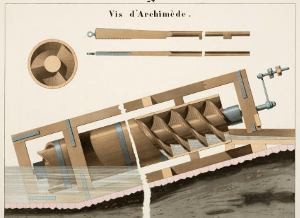Nov 21 2016
Researchers at CQT and their international collaborators present a scheme that could move groups of quantum particles about in future quantum computers
 The inspiration for a new scheme to transport interacting quantum particles has its roots in Ancience Greece. In Thouless pumping, transport happens because of the topology of fields acting on the quantum particles – similar to the way that an Archimedes' screw pump can move water up a hill. (Credit: Embed from Getty)
The inspiration for a new scheme to transport interacting quantum particles has its roots in Ancience Greece. In Thouless pumping, transport happens because of the topology of fields acting on the quantum particles – similar to the way that an Archimedes' screw pump can move water up a hill. (Credit: Embed from Getty)
In October 2016, physicist David J. Thouless won half the Nobel Prize in physics for his work on topological effects in materials. The latest paper from CQT researchers and their collaborators shows the ongoing impact of his discoveries.
One of Thouless' major contributions was the invention of topological pumping: the efficient transport of quantum particles in a lattice by exploiting the topological properties of the system. The new proposal, published 17 November in Physical Review Letters, is a scheme to pump interacting particles, enabling the efficient transport of a whole new class of quantum states.
The technique could be used for moving information around in a future quantum computer. It could also give insight into the phenomenon known as the fractional quantum Hall effect. The Hall effect is important to researchers trying to build quantum technologies because it is resistant to noise – a necessary property for efficient quantum devices.
From Ancient Greece to Google
CQT's Dimitris Angelakis and his group members collaborated with scientists at the University of Oxford, UK and at Google in Santa Barbara, to propose a way to reliably transport quantum states of a few photons along a line of circuit-QED devices.
Co-author Pedram Roushan is part of the Google group building superconducting circuits for quantum computing – and the team hopes to see the idea implemented in similar hardware. "This paper is almost a blueprint," says Dimitris, who is also an Assistant Professor at the Technical University of Crete.
Topological pumping works something like Archimedes' screw pump – a method invented by the Ancient Greek to pump water up a hill using a rotating screw.
"Even though the motion of the machine is cyclical, the motion of the particles is not, they move in a line," explains Dimitris' PhD student Jirawat Tangpanitanon, first author on the new paper. In the quantum scheme, the screw thread is not a physical structure but a modulating potential imposed by electronic control over the circuit-QED devices.
In 2015, a few groups worldwide demonstrated topological pumping of individual, non-interacting quantum particles in different systems. "Seeing the papers out, I felt this was timely. My team dug into it," says Dimitris.
Conversations started with Pedram when Dimitris and Jirawat spent a few months in Santa Barbara during a program at the Kavli Institute for Theoretical Physics there. The conversations continued when Research Fellow Victor Bastidas joined the group, and concluded during a conference in Crete, Greece in June 2016. They had the paper on the physics preprint server the following month.
Let's stick together
The challenge for transporting groups of interacting quantum particles is making sure they stay together, something like a molecule. The team carried out numerical simulations with support from CQT colleague Dieter Jaksch and Sarah Al-Assam at Oxford to test their proposed scheme. The simulations show that it should move a three-photon state from one circuit site to the next over dozens of sites: the particles jump as a whole through the bulk of the lattice and appear at the other end undisturbed, with no spreading out.
Unlike Archimede's pump, which can only move water one way, the quantum particles can even be sent into reverse by changing the initial conditions. "It's like a moonwalk," jokes Jirawat. It looks like everything should be moving forward, but instead the particles go backwards due to quantum effects.
The team think the scheme could be generalized to other states and setups too. The team's next plans include work on protocols for moving entangled quantum states and exploring further the connections with fractional Hall physics.